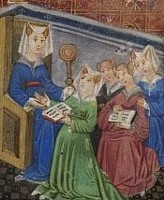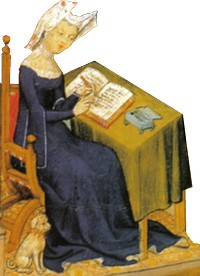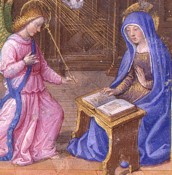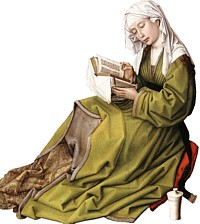|

Education
Opportunities For Medieval Women
PEASANT WOMEN - TOWNSWOMEN - NOBLE WOMEN
 One
of the great medieval myths is that women could neither read nor
write and were completely dependent upon others to do these for
her. Nothing could be further from the truth. One
of the great medieval myths is that women could neither read nor
write and were completely dependent upon others to do these for
her. Nothing could be further from the truth.
Educational opportunities for medieval women, like so many other
things, depended on a woman's station at birth. Many women could
both read and write to some extent. Many could only read. The
frequency which this occurred increased as the medieval period
progressed from century to century.
Pictured at right is a detail
from a 1445 Netherlands prayerbook by the Masters of the Gold
Scrolls. At this period, it was not uncommon for women to
be able to read and to teach others to do so.
In the 14th century, women increasingly became book owners and
romance story readers. Some had books specially commissioned for
them- beautifully illustrated Books of Hours.

Peasant
Women
Peasant women has far less opportunity for a formal education
than her wealthy counterpart. Many received little or no education
unless they lived in or near the town. For the most part, the
extent of their learning was the alphabet and verbal religion
instruction. Peasants were generally employed in outdoor duties
and a written record of her household expenses was not necessary.
The primary teachers of small
girls were their own mothers or grandmothers. Girls assisted their
mothers at a very young age. Jobs such as pulling of wool for
spinning, weeding in the garden, sewing, cooking and caring for
the chickens prepared girls to have the skills they would use
in later life as wives and mothers.
Girls learned to hand-sew clothing and make repairs, like darning,
at a young age so that when a young woman became head of her own
household, she would be adequately prepared to clothe her family
in durable and well-made clothing making the best of what resources
were available to her.

Townswomen
and middle-class urban women
Most middle class girls were taught to read and write. A woman's
education started at home under the care of her mother or nurse.
Some girls had the opportunity to be educated by being sent to
a nunnery and learning to read and write there under the supervision
of educated women, although this would only be an option for daughters
of wealthy businessman.  Many
families thought it more important for a girl to be better educated
with proper manners than intellectual lessons, however those who
wished their daughters to marry well, saw the value of a daughter
who could read and write well. Such a young woman could make a
valuable wife and therefore had better marriage prospects. A woman
who could not read or write with proficiency could hardly be expected
to run a successful household. Many
families thought it more important for a girl to be better educated
with proper manners than intellectual lessons, however those who
wished their daughters to marry well, saw the value of a daughter
who could read and write well. Such a young woman could make a
valuable wife and therefore had better marriage prospects. A woman
who could not read or write with proficiency could hardly be expected
to run a successful household.
Many wealthy townswomen commissioned
prayer books which could be read to their daughters for their
spiritual education. Women were not expected to make a living
from writing, and indeed, it seems that chroniclers of the medieval
period are almost entirely men.
One example of a women whose literacy skills were of a high standard
is that of French writer, Christine de Pisan. Shown at left is
a self portrait from 1364-1430 taken from the Works of Christine
de Pisan. Her books were written for an exclusive audience
of female readers and incorporated themes which were relevant
to women.
 The
fact that her books were written for women tells us that there
were enough women educated well enough to read them. Christine
was married at 15 and a widowed woman by 25 who supported her
three children with her writing. The
fact that her books were written for women tells us that there
were enough women educated well enough to read them. Christine
was married at 15 and a widowed woman by 25 who supported her
three children with her writing.
The image shown at left is
a detail from a prayer book owned by Anne de Bretane, a mother,
who commissioned the prayer book herself. It shows a woman learning
to read in order to study the scriptures.
There are many images of this kind in manuscripts.

Noble
women & upper class women
It was not uncommon for daughters of wealthy nobles and upper
class families to be educated in a nunnery. Such a girl would
also have her spiritual education tended to as well as learning
to read and write. Upper class girls would often be sent to other
households to learn other aspects of her education which would
prepare her for marriage.
A noble woman's daughter
might also learn literacy from a nurse or someone especially employed
for that purpose. In a world where a nobleman's wife was expected
to run not only her own household, but that of her husband's estates
in his absence, it was imperative that she be literate and have
reasonable mathematical skills so that she might run these with
efficiency and be able to check whether her household costings
seemed reasonable.
 She
was not responsible for all expenditure of the household, but
certainly needed to know enough about business management to see
that it was being run properly. She
was not responsible for all expenditure of the household, but
certainly needed to know enough about business management to see
that it was being run properly.
Queen Anne, wife of Richard
II, brought many books and illustrators from her native Bohemia
with her to England and enjoyed reading.
Wills during Chaucer's period show that many women bequeathed
books to other women- showing that women of all generations were
literate and read for pleasure. These books were both devotional
and works of romance.
One example is is the 1390-1391 will of the Countess of Devon,
Margaret Courtenay. Her books included primers, a medical book
and stories of Tristram, Merlin and Arthur. These treasures she
left to her daughters and a woman friend. Her daughters also were
left books from her husband. No books were left to her sons.
Young girls were taught to
read, write, tell stories, read romances and judge the merits
of poetry. They often undertook singing lessons and were instructed
in one or more musical instruments. It goes without saying that
a noble woman was well-schooled in manners and courtesy. Lack
of such refinement did not encourage social advancement.
A noble woman might also have read for leisure- romances and poems
as well as holy scriptures.

Copyright
© Rosalie Gilbert
All text & photographs within this site are the property of
Rosalie Gilbert unless stated.
Art & artifact images remain the property of the owner.
Images and text may not be copied and used without permission.
|